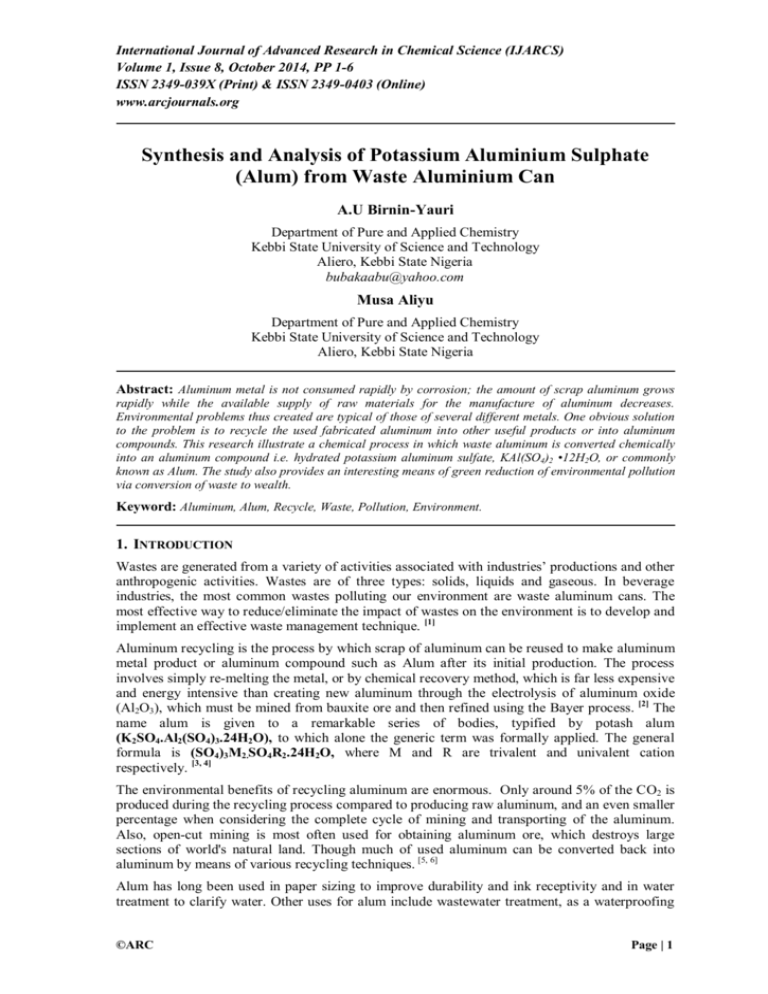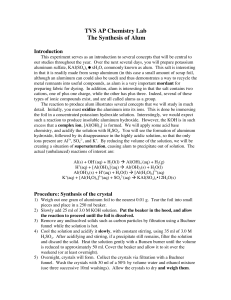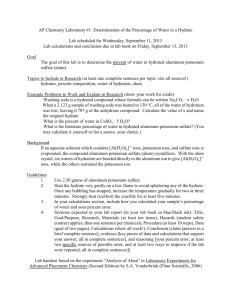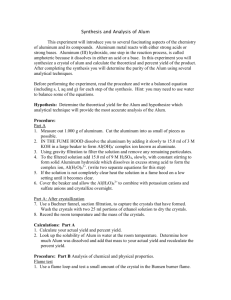Synthesis and Analysis of Potassium Aluminium Sulphate (Alum
advertisement

International Journal of Advanced Research in Chemical Science (IJARCS) Volume 1, Issue 8, October 2014, PP 1-6 ISSN 2349-039X (Print) & ISSN 2349-0403 (Online) www.arcjournals.org Synthesis and Analysis of Potassium Aluminium Sulphate (Alum) from Waste Aluminium Can A.U Birnin-Yauri Department of Pure and Applied Chemistry Kebbi State University of Science and Technology Aliero, Kebbi State Nigeria bubakaabu@yahoo.com Musa Aliyu Department of Pure and Applied Chemistry Kebbi State University of Science and Technology Aliero, Kebbi State Nigeria Abstract: Aluminum metal is not consumed rapidly by corrosion; the amount of scrap aluminum grows rapidly while the available supply of raw materials for the manufacture of aluminum decreases. Environmental problems thus created are typical of those of several different metals. One obvious solution to the problem is to recycle the used fabricated aluminum into other useful products or into aluminum compounds. This research illustrate a chemical process in which waste aluminum is converted chemically into an aluminum compound i.e. hydrated potassium aluminum sulfate, KAl(SO4)2 •12H2O, or commonly known as Alum. The study also provides an interesting means of green reduction of environmental pollution via conversion of waste to wealth. Keyword: Aluminum, Alum, Recycle, Waste, Pollution, Environment. 1. INTRODUCTION Wastes are generated from a variety of activities associated with industries’ productions and other anthropogenic activities. Wastes are of three types: solids, liquids and gaseous. In beverage industries, the most common wastes polluting our environment are waste aluminum cans. The most effective way to reduce/eliminate the impact of wastes on the environment is to develop and implement an effective waste management technique. [1] Aluminum recycling is the process by which scrap of aluminum can be reused to make aluminum metal product or aluminum compound such as Alum after its initial production. The process involves simply re-melting the metal, or by chemical recovery method, which is far less expensive and energy intensive than creating new aluminum through the electrolysis of aluminum oxide (Al2O3), which must be mined from bauxite ore and then refined using the Bayer process. [2] The name alum is given to a remarkable series of bodies, typified by potash alum (K2SO4.Al2(SO4)3.24H2O), to which alone the generic term was formally applied. The general formula is (SO4)3M2.SO4R2.24H2O, where M and R are trivalent and univalent cation respectively. [3, 4] The environmental benefits of recycling aluminum are enormous. Only around 5% of the CO2 is produced during the recycling process compared to producing raw aluminum, and an even smaller percentage when considering the complete cycle of mining and transporting of the aluminum. Also, open-cut mining is most often used for obtaining aluminum ore, which destroys large sections of world's natural land. Though much of used aluminum can be converted back into aluminum by means of various recycling techniques. [5, 6] Alum has long been used in paper sizing to improve durability and ink receptivity and in water treatment to clarify water. Other uses for alum include wastewater treatment, as a waterproofing ©ARC Page | 1 A.U Birnin-Yauri & Musa Aliyu agent and accelerator in concrete, as a clarifier for fats and oils and as a foaming agent in fire foams. [7] Hein, the waste aluminum beverage containers (Figure 1) are converted into potassium aluminum sulphate with the view of reducing these waste from the environment through recycling them into useful products. Figure 1. Aluminum beverages containers 2. MATERIALS AND METHOD Materials: Waste can, scissors, sand paper etc. Method: The waste aluminum can is obtained and the paint removed. The polymer coating on the inside of the can was also removed, then it was cut into pieces of approximately 5 cm x 7.5 cm. The cleaned pieces of aluminum were weighted approximately 1.0 g and transferred into 250 ml beaker. The 250 mL beaker containing aluminum pieces (Figure 2) was placed in a fume hood and 25 mL of 3 M KOH solution was added slowly, waited for about 15 minutes or until all of the aluminum pieces have finished reacting. The reaction was complete when no more aluminum pieces were visible and no more gas was evolving. The above reactions are summarized in equations 1 and 2 below: 2 Al(s) + 2 KOH (aq) + 6 H2O (liq) → 2 KAl(OH)4(aq) + 3 H2(g) (1) Or the net ionic equation 2 Al(s) + 2 OH-(aq) + 6 H2O(liq) → 2 Al(OH)4-(aq) + 3 H2(g) (2) The cold black solution formed (Figure 2) was filtered through a funnel attached with a filter paper into the 100 mL beaker and rinsed 250 mL beaker and filter paper with distilled water. The filtrate was colourless solution which is Aluminate ion complex [Al(OH)4]- and black residue as a result of residual plastic and paint decomposition was retained on the filter paper. Then, cold 35 mL of 3 M H2SO4 solution was added slowly from the burette with constant stirring into the colorless solution. Initially, a thick, white, gelatinous precipitate of aluminum hydroxide, Al(OH)3 was formed, as more acid was added the precipitate dissolved. The solution was boiled to evaporate excess quantity of water and then the solution was left undisturbed overnight. The above reactions are summarized in equations 3 to 6 below: 2 KAl(OH)4(aq) + H2SO4(aq) → 2 Al(OH)3(s) + 2 H2O(liq) + K2SO4(aq) (3) Or the net ionic equation 2 Al(OH)4-(aq) + 2 H+(aq) → 2 Al(OH)3(s) + 2 H2O(liq) (4) As more sulfuric acid is added, the precipitate of Al (OH)3 dissolved. The complete reaction is 2 Al(OH)3(s) + 3 H2SO4(aq) → Al2(SO4)3(aq) + 6 H2O(liq) (5) Or the net ionic equation is International Journal of Advanced Research in Chemical Science (IJARCS) Page 2 Synthesis and Analysis of Potassium Aluminium Sulphate (Alum) from Waste Aluminium Can 2 Al(OH)3(s) + 6 H+(aq) → 2 Al3+(aq) + 6 H2O(liq) 3+ + (6) 2- The solution at this point contains Al ions, K ions (from potassium hydroxide), and SO4 ions (Figure 3). When the solution is cooled, Alum crystals began to form. Finally, the Alum crystal was removed from the solution after 20 hours by filtration and washed with 12 v/v alcohol/water mixture. This wash liquid removes any contamination from the crystals but does not dissolve them. It also helps to dry the crystals quickly, because alcohol is more volatile than water, and it reduces the solubility of crystal. The crystal was placed on filter paper and allowed to dry overnight and then it was weighed. The complete equation of reaction is given in equation 7 below; Al2(SO4)3(aq) + K2SO4(aq) + 24 H2O(liq) → 2 KAl(SO4)2•12 H2O(s) (7) Or the net ionic equation is: 2 K+(aq) + 2 Al3+(aq) + 4 SO42-(aq) + 24 H2O(liq) → 2 KAl(SO4)2•12 H2O(s) (8) The synthesized Alum crystal was analysed qualitatively and quantitatively, and also coagulation test (Figure 5) of the Alum crystal in treatment of waste water and effect of heat on coagulation were carried out. Figure 2. Formation of AluminateIon complex Figure 3. Formation of K+, Al3+ and SO42- ions International Journal of Advanced Research in Chemical Science (IJARCS) Page 3 A.U Birnin-Yauri & Musa Aliyu Figure 4. Synthesized Alum Crystal Figure 5. Coagulation actions of Alum crystals at 70 25 3. RESULTS AND DISCUSSION Results: The results on qualitatative analysis of the synthesized alum crystal is given in table 1and for the quantitative, calculated values and coagulation test carried out are shown in tables 3, 4 and 5 respectively. Table 1. Qualitative analysis result of ions presence in synthesized Alum crystal. Test Observation Inference Alum solution + Aqueous BaCl2 Solution White Precipitate formed, and insoluble (After 20 hours) SO42- Confirmed Solid Alum Crystal + heat (10 minutes) Red flame turned to lavender (pale purple) flame color K+ Confirmed Aluminate ion Solution + H2SO4(aq) In drop and in Excess thick, white gelatinous precipitate formed, insoluble in drop but soluble in excess Al3+ Confirmed Table 2. Quantitative analysis of ions presence in synthesized Alum crystal. Ions Al3+ K+ SO42- Conc. (ppm) Mean ± SD 1898.059 ± 0.0008 2150.000 ± 0.000 1233.130 ± 0.000 Mean Absorption Method 0.0404 ----- AAS Flame photometry Gravimetry International Journal of Advanced Research in Chemical Science (IJARCS) Page 4 Synthesis and Analysis of Potassium Aluminium Sulphate (Alum) from Waste Aluminium Can Table 3. Result for test of Coagulation action of synthesized Alum crystal. Parameters Volume of muddy water (ml) (Before coagulation) pH of muddy water (Before coagulation) Mass of Alum Crystal Applied (g) Appearance of water (Before coagulation) Rate at which alum Dissolved at 70 /25 Volume of water (ml) (After coagulation) at 70 /25 Appearance of water(After coagulation) at 70 /25 pH of muddy water (After coagulation) at 70 /25 Test tube A Test tube B Test tube C 10.0 10.0 10.0 4.57 4.57 4.57 0.5 0.7 1.0 muddy muddy muddy 5 min/5.20 hrs 7 min/5.45 hrs. 9 min/6.25 hrs. 8.9/8.2 9.2/8.5 Cleared and colorless Cleared and colorless Cleared and colorless 3.52/3.81 3.43/3.67 3.42/3.61 9.3/8.7 Table 4. Summary of calculated values Parameter Mass of Alum obtained Number of mole of Aluminum used Number of mole of Alum Theoretical yield of Alum Percentage yield of Alum Number of mole Water of crystallization Mass Conc. (ppm) of SO42- Calculated value 9.780 g 0.037 moles 0.650 moles 308.350 g 3.17 % 12.259 ± 0.070 1233.130 ± 0.000 4. DISCUSSION The dissolution of Al(s) in aqueous KOH is an example of an oxidation-reduction or redox reaction. The Al metal is oxidized to aluminum with an oxidation number of +3 and the hydrogen in KOH or in water is reduced from an oxidation number of +1 to zero in hydrogen gas.The Al(OH)4- ion is a complex ion called “aluminate." The reaction between aluminate ion and sulphuric acid is an acid-base reaction in which the H+ ions from the sulfuric acid neutralize the base Al(OH)4-. Initially, a thick, white, gelatinous precipitate of aluminum hydroxide, Al(OH)3 was formed as more acid is added, the precipitate dissolved. The solution at this point contains Al3+ ions, K+ ions (from potassium hydroxide), and SO42- ions (from sulfuric acid) equations (1) &(2). However, the qualitative analysis of the Alum crystal formed indicated insoluble white precipitate when reacted with Barium chloride confirming the presence of sulphate ions. While a blue flame of Bunsen burner and pale purple (lavender) color produced, this confirmed the presence of potassium ion (K+) in the solid crystal. The quantitative analysis of the Alum crystal indicated that it contained Aluminum and Potassium with concentration (ppm) 1898.059 ± 0.0008 and 2150 ± 0.006. International Journal of Advanced Research in Chemical Science (IJARCS) Page 5 A.U Birnin-Yauri & Musa Aliyu Coagulation action of synthesized alum is found to be very effective, but upon application of heat the rate at which alum crystals dissolved differed at different temperature range but the suspended particles in the waste water was observed to settle irrespective of temperature applied in both two processes. Sequel to the results obtained from qualitative, quantitative analysis and coagulation action of synthesized Alum crystal, the chemical recovery method was found to be effective and efficient way to recycle the aluminum scrap. The Alum crystal obtained by this process is of best quality, as the use of aluminum cans for soft drinks companies are increasing, subsequently waste are increasing and a large number of Aluminum scrap is generated. Thus, integration and design of chemical recovery plant of aluminum scrap will surely contained the environmental pollution pose by this aluminum scrap. 5. CONCLUSION Aluminum waste containers recycling is highly feasible and could provides many environmental, economic and community benefits to individuals, communities, organizations, companies and industries. Aluminum cans are currently recycled to make more aluminum products such as alum, with an energy savings of 95 percent over refining and smelting bauxite ore. Alum is a chemical used in a myriad of applications including water purification, make-up, deodorant, hardening gelatin, baking powders, hardening plaster casts, and as a medicinal astringent. ACKNOWLEDGEMENT Department of Pure and Applied Chemistry, Kebbi State University of Science and Technology, Aliero, Nigeria. Department of Chemistry, Ahmadu Bello University, Zaria, Nigeria. REFERENCES [1] Aluminum recycling (2013). “Recycling Aluminum Industries in Nigeria”. Available on www.environmental-expert.com/companies/keyword-aluminum-recyling-3115/locationnigeria, Access on 12/25/2013 by 10:35 a.m. [2] Chris, O. O., (2010). “Environmental Sustainability and Waste management” Journal Article, 2010. Chemical society of Nigeria, CSN. Pp44-49. [3] David C., (2004). “Aluminum Can Recycling” Available on http://www.cancentral.com/funFacts.cfm Access on 12/25/2023 by 1:40 p.m. [4] Lambert, J. L., Lambert M. W. (1970), “The Alums: interchangeable elements in a versatile crystal structure.” J. Chem. Edu. 1970, pp., 47, 465 Available on (Chemistry.about.com/od/moleculescompounds/f/what-Is-Alum.html), Access on 12/27/2013 by 11:30 a.m. [5] Rayner H. (1974). “The early history of alum” Available on http://www.wovepaper.co.uk/ alumessay1.html) [6] St. Peter J. (1942). “The light metals: aluminum and magnesium.” J. Chem. Edu. 1942, 19, 556. Available on (http://www.madehow.com/Volume-2/Aluminum-Beverage-Can.html [7] Ugwekar R.P., Lakhawat G.P. (2012), “Potash Alum from Waste and Medicinal Foil” Journal article. 2012. IOSR Journal of Engineering (IOSRJEN), ISSN: 2250-3021 Volume 2, Issue 7(July 2012), PP 62-64 International Journal of Advanced Research in Chemical Science (IJARCS) Page 6






